 Introduction
Introduction
Employees Provident Fund Organisation (EPFO) has announced a notification for the recruitment of Assistant Posts. Candidates who are interested and meet all eligibility criteria can read the Official Notification issued by EPFO. EPFO Assistant 2019 Preliminary Exam would be held on [latex]{30}^{th}[/latex]July 2019 and [latex]{31}^{st}[/latex]July 2019.
The article EPFO Assistant Prelims Model Paper 1 provides pattern Questions, and it helps the candidates to devise effective preparation strategies, by focusing on their strengths and weaknesses in different topics and also useful to the candidates while preparing Various Insurance, Banking & Government Exams like SBI PO, SBI Clerk, SSC CPO, SSC CHSL.
Preliminary Examination is important to qualify for the Mains Examination. Below mentioned data gives an overview of the EPFO Assistant Prelims Model Paper . The paper is divided into three sections i.e., Reasoning ability, Numerical Aptitude, and English Language.
 Pattern
Pattern
| EPFO Assistant Exam Pattern – Prelims | |||||
|---|---|---|---|---|---|
| S. No. | Name of the Test (Objective Tests) | No. of Questions | Maximum Marks | Duration | Version |
| 1 | English Language | 30 | 30 | 20 Minutes | English |
| 2 | Reasoning Ability | 35 | 35 | 20 Minutes | Bilingual |
| 3 | Numerical Aptitude | 35 | 35 | 20 Minutes | Bilingual |
| Total | 100 Questions | 100 Marks | 60 Minutes | ||
 Model
Model
Direction (1-3): The question are based on the five three-digit numbers given below.
937 425 816 398 671
1. If the position of the first and the third digits within each number are reversed, which of the following will be the third digit of the second lowest number?
5. How many movies were shown between Padmavat and Gold?
6. Which movie was shown on Sunday?
7. If Gold is related to 275, Indian is related to 350, then Kalank is related to?
8. Which of the following movie was being watched by 350 people?
Direction(9-14):In each of the questions below are given few statements followed by two conclusions numbered I and II. You have to take the given statements to be true even if they seem to be at variance with commonly known facts. Read all the conclusions and then decide which of the given conclusions logically follows from the given statements, disregarding commonly known facts.
9. Statements:
S1. Some R are C.
S2. All P are R.
S3. All C are B.
Conclusions:
I. Some B being P is a possibility.
II. All P being B is a possibility.
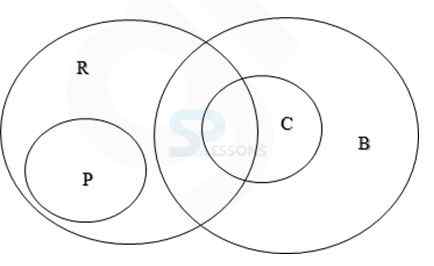 10. Statements:
S1. All maths is science.
S2. Some science is biology.
S3. Some science is History.
Conclusion:
I. Some History are Maths.
II. Some Maths are not History.
10. Statements:
S1. All maths is science.
S2. Some science is biology.
S3. Some science is History.
Conclusion:
I. Some History are Maths.
II. Some Maths are not History.
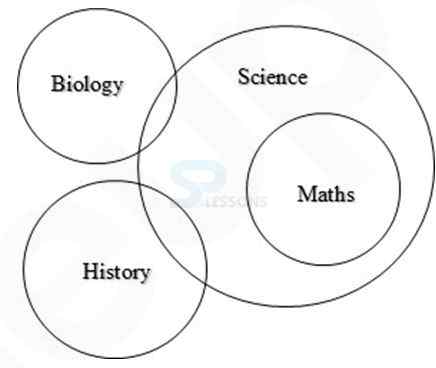 11. Statements:
S1. Some W are P.
S2. Some T are F.
S3. Some P are F.
Conclusions:
I. All W are F is a possibility
II. Some P are T is a possibility
11. Statements:
S1. Some W are P.
S2. Some T are F.
S3. Some P are F.
Conclusions:
I. All W are F is a possibility
II. Some P are T is a possibility
 12. Statements:
S1. No G is J.
S2. Some U are N.
S3. All N are G.
Conclusions:
I. Some N are not U.
II. Some N are not J is a possibility.
12. Statements:
S1. No G is J.
S2. Some U are N.
S3. All N are G.
Conclusions:
I. Some N are not U.
II. Some N are not J is a possibility.
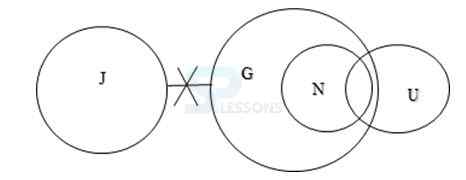 13. Statements:
S1. All C are T.
S2. All N are B.
S3. Some C are B.
Conclusions:
I. All B are T is a possibility.
II. Some N are not T.
13. Statements:
S1. All C are T.
S2. All N are B.
S3. Some C are B.
Conclusions:
I. All B are T is a possibility.
II. Some N are not T.
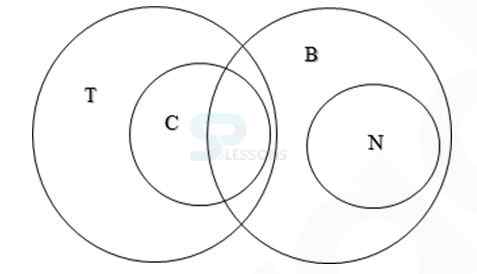 Direction(14-16):In the question, the relationships between two or more elements are shown in the statements. These statements are followed by two conclusions. Read the statements and give answer.
14. Statement:
B >= C, G = K > M, O = R, G >= D = C, O < M
Conclusion:
I. B > G
II. K > R
Direction(14-16):In the question, the relationships between two or more elements are shown in the statements. These statements are followed by two conclusions. Read the statements and give answer.
14. Statement:
B >= C, G = K > M, O = R, G >= D = C, O < M
Conclusion:
I. B > G
II. K > R
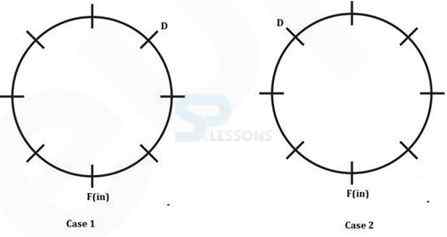
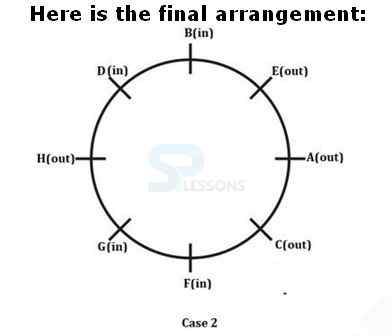 18. Which of the following doesn’t belong to the group?
18. Which of the following doesn’t belong to the group?

 19. Who among the following sits exactly between D and E?
19. Who among the following sits exactly between D and E?

 20. Which of the following is TRUE?
20. Which of the following is TRUE?

 21. How many persons are sitting between G and B if counted from the left of G?
21. How many persons are sitting between G and B if counted from the left of G?

 Direction(22 – 26): Study the following information carefully to answer the given questions.
In a certain language,
Direction(22 – 26): Study the following information carefully to answer the given questions.
In a certain language,
 28. In a row of students in a class, position of Andrew from the left side of the row is 32nd and position of Andrew from right side of the row is 41st. Find the total number of students in the row?
28. In a row of students in a class, position of Andrew from the left side of the row is 32nd and position of Andrew from right side of the row is 41st. Find the total number of students in the row?
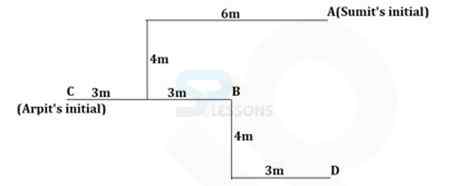 30. In which of the following direction is Arpit’s initial position with respect to point A?
30. In which of the following direction is Arpit’s initial position with respect to point A?
 Direction (31 – 35): Study the following information carefully and answer the questions given below.
Eight people- A, B, C, D, E, F, G and H are sitting in a straight line with equal distances between each other, but not necessarily in the same order. Some of them are facing north and some are facing south.
A sits at one extreme end of the line. Only three people sit between A and G. E and A and E and G have the same members between them. H sits third to the right of E. B is an immediate neighbour of H and faces south. C sits second to the right of F. C is not an immediate neighbour of G. Immediate neighbours of G face opposite directions (i.e. if one neighbour faces north then the other neighbour faces south and vice-versa). Immediate neighbours of F face opposite directions. A and D face the same direction as E (i.e. if E faces north then A and D also face north and vice-versa.). Both the immediate neighbour of E faces south.
31. How many persons facing South?
Direction (31 – 35): Study the following information carefully and answer the questions given below.
Eight people- A, B, C, D, E, F, G and H are sitting in a straight line with equal distances between each other, but not necessarily in the same order. Some of them are facing north and some are facing south.
A sits at one extreme end of the line. Only three people sit between A and G. E and A and E and G have the same members between them. H sits third to the right of E. B is an immediate neighbour of H and faces south. C sits second to the right of F. C is not an immediate neighbour of G. Immediate neighbours of G face opposite directions (i.e. if one neighbour faces north then the other neighbour faces south and vice-versa). Immediate neighbours of F face opposite directions. A and D face the same direction as E (i.e. if E faces north then A and D also face north and vice-versa.). Both the immediate neighbour of E faces south.
31. How many persons facing South?
 32. Who sits at the end of the line?
32. Who sits at the end of the line?
 33. Who among the following lives second to the left of F?
33. Who among the following lives second to the left of F?
 34. How many persons live between A and F?
34. How many persons live between A and F?
 35. Find the odd one out?
35. Find the odd one out?

-
A. 8
B. 9
C. 4
D. 6
E. None of these
-
A. 12
B. 6
C. 9
D. 13
E. None of these
-
A. 3
B. 2
C. 1
D. 9
E. 7
-
A. 350
B. 200
C. 275
D. 315
E. None of these
Final Arrangement |
||
|---|---|---|
| Days | Movies | Persons |
| Monday | Padmavat | 350 |
| Tuesday | Indian | 200 |
| Wednesday | Dil | 230 |
| Thursday | Kalank | 380 |
| Friday | Dhadkan | 275 |
| Saturday | Gold | 315 |
| Sunday | Deevdas | 245 |
Case-1 |
||
|---|---|---|
| Days | Movies | Persons |
| Monday | ||
| Tuesday | ||
| Wednesday | ||
| Thursday | Kalank | |
| Friday | 275 | |
| Saturday | Gold | |
| Sunday | ||
Case-2 |
||
|---|---|---|
| Days | Movies | Persons |
| Monday | ||
| Tuesday | Gold | |
| Wednesday | ||
| Thursday | Kalank | |
| Friday | 275 | |
| Saturday | ||
| Sunday | ||
-
A. Four
B. Three
C. Two
D. Five
E. None
Final Arrangement |
||
|---|---|---|
| Days | Movies | Persons |
| Monday | Padmavat | 350 |
| Tuesday | Indian | 200 |
| Wednesday | Dil | 230 |
| Thursday | Kalank | 380 |
| Friday | Dhadkan | 275 |
| Saturday | Gold | 315 |
| Sunday | Deevdas | 245 |
Case-1 |
||
|---|---|---|
| Days | Movies | Persons |
| Monday | ||
| Tuesday | ||
| Wednesday | ||
| Thursday | Kalank | |
| Friday | 275 | |
| Saturday | Gold | |
| Sunday | ||
Case-2 |
||
|---|---|---|
| Days | Movies | Persons |
| Monday | ||
| Tuesday | Gold | |
| Wednesday | ||
| Thursday | Kalank | |
| Friday | 275 | |
| Saturday | ||
| Sunday | ||
-
A. Indian
B. Gold
C. Dhadkan
D. Devdas
E. None of these
Final Arrangement |
||
|---|---|---|
| Days | Movies | Persons |
| Monday | Padmavat | 350 |
| Tuesday | Indian | 200 |
| Wednesday | Dil | 230 |
| Thursday | Kalank | 380 |
| Friday | Dhadkan | 275 |
| Saturday | Gold | 315 |
| Sunday | Deevdas | 245 |
Case-1 |
||
|---|---|---|
| Days | Movies | Persons |
| Monday | ||
| Tuesday | ||
| Wednesday | ||
| Thursday | Kalank | |
| Friday | 275 | |
| Saturday | Gold | |
| Sunday | ||
Case-2 |
||
|---|---|---|
| Days | Movies | Persons |
| Monday | ||
| Tuesday | Gold | |
| Wednesday | ||
| Thursday | Kalank | |
| Friday | 275 | |
| Saturday | ||
| Sunday | ||
-
A. Saturday
B. Tuesday
C. Friday
D. Wednesday
E. None of these
Final Arrangement |
||
|---|---|---|
| Days | Movies | Persons |
| Monday | Padmavat | 350 |
| Tuesday | Indian | 200 |
| Wednesday | Dil | 230 |
| Thursday | Kalank | 380 |
| Friday | Dhadkan | 275 |
| Saturday | Gold | 315 |
| Sunday | Deevdas | 245 |
Case-1 |
||
|---|---|---|
| Days | Movies | Persons |
| Monday | ||
| Tuesday | ||
| Wednesday | ||
| Thursday | Kalank | |
| Friday | 275 | |
| Saturday | Gold | |
| Sunday | ||
Case-2 |
||
|---|---|---|
| Days | Movies | Persons |
| Monday | ||
| Tuesday | Gold | |
| Wednesday | ||
| Thursday | Kalank | |
| Friday | 275 | |
| Saturday | ||
| Sunday | ||
-
A. Padmavat
B. Indian
C. Dil
D. Devdas
E. None of these
Final Arrangement |
||
|---|---|---|
| Days | Movies | Persons |
| Monday | Padmavat | 350 |
| Tuesday | Indian | 200 |
| Wednesday | Dil | 230 |
| Thursday | Kalank | 380 |
| Friday | Dhadkan | 275 |
| Saturday | Gold | 315 |
| Sunday | Deevdas | 245 |
Case-1 |
||
|---|---|---|
| Days | Movies | Persons |
| Monday | ||
| Tuesday | ||
| Wednesday | ||
| Thursday | Kalank | |
| Friday | 275 | |
| Saturday | Gold | |
| Sunday | ||
Case-2 |
||
|---|---|---|
| Days | Movies | Persons |
| Monday | ||
| Tuesday | Gold | |
| Wednesday | ||
| Thursday | Kalank | |
| Friday | 275 | |
| Saturday | ||
| Sunday | ||
-
A. If only conclusion I follows
B. If only conclusion II follows
C. If either conclusion I or conclusion II follows
D. If neither conclusion I nor conclusion II follows
E. If both conclusion I and conclusion II follow
 10. Statements:
S1. All maths is science.
S2. Some science is biology.
S3. Some science is History.
Conclusion:
I. Some History are Maths.
II. Some Maths are not History.
10. Statements:
S1. All maths is science.
S2. Some science is biology.
S3. Some science is History.
Conclusion:
I. Some History are Maths.
II. Some Maths are not History.
-
A. If only conclusion I follows.
B. If only conclusion II follows.
C. If either conclusion I or conclusion II follows.
D. If neither conclusion I nor conclusion II follows.
E. If both conclusion I and conclusion II follow.
 11. Statements:
S1. Some W are P.
S2. Some T are F.
S3. Some P are F.
Conclusions:
I. All W are F is a possibility
II. Some P are T is a possibility
11. Statements:
S1. Some W are P.
S2. Some T are F.
S3. Some P are F.
Conclusions:
I. All W are F is a possibility
II. Some P are T is a possibility
-
A. If only conclusion I follows.
B. If only conclusion II follows.
C. If either conclusion I or conclusion II follows.
D. If neither conclusion I nor conclusion II follows.
E. If both conclusion I and conclusion II follow.
 12. Statements:
S1. No G is J.
S2. Some U are N.
S3. All N are G.
Conclusions:
I. Some N are not U.
II. Some N are not J is a possibility.
12. Statements:
S1. No G is J.
S2. Some U are N.
S3. All N are G.
Conclusions:
I. Some N are not U.
II. Some N are not J is a possibility.
-
A. If only conclusion I follows.
B. If only conclusion II follows.
C. If either conclusion I or conclusion II follows.
D. If neither conclusion I nor conclusion II follows.
E. If both conclusion I and conclusion II follow.
 13. Statements:
S1. All C are T.
S2. All N are B.
S3. Some C are B.
Conclusions:
I. All B are T is a possibility.
II. Some N are not T.
13. Statements:
S1. All C are T.
S2. All N are B.
S3. Some C are B.
Conclusions:
I. All B are T is a possibility.
II. Some N are not T.
-
A. If only conclusion I follows.
B. If only conclusion II follows.
C. If either conclusion I or conclusion II follows.
D. If neither conclusion I nor conclusion II follows.
E. If both conclusion I and conclusion II follow.
 Direction(14-16):In the question, the relationships between two or more elements are shown in the statements. These statements are followed by two conclusions. Read the statements and give answer.
14. Statement:
B >= C, G = K > M, O = R, G >= D = C, O < M
Conclusion:
I. B > G
II. K > R
Direction(14-16):In the question, the relationships between two or more elements are shown in the statements. These statements are followed by two conclusions. Read the statements and give answer.
14. Statement:
B >= C, G = K > M, O = R, G >= D = C, O < M
Conclusion:
I. B > G
II. K > R
-
A. Only conclusion I is true
B. Only conclusion II is true
C. Either conclusion I or II is true
D. Neither conclusion I or II is true
E. Both conclusion I and conclusion II is true
-
A. Only conclusion I is true
B. Only conclusion II is true
C. Either conclusion I or II is true
D. Neither conclusion I or II is true
E. Both conclusion I and conclusion II is true
-
A. Only conclusion I is true
B. Only conclusion II is true
C. Either conclusion I or II is true
D. Neither conclusion I or II is true
E. Both conclusion I and conclusion II is true
-
A. H
B. D
C. A
D. F
E. C

 18. Which of the following doesn’t belong to the group?
18. Which of the following doesn’t belong to the group?
-
A. B
B. A
C. E
D. H
E. C

 19. Who among the following sits exactly between D and E?
19. Who among the following sits exactly between D and E?
-
A. A
B. C
C. B
D. H
E. F

 20. Which of the following is TRUE?
20. Which of the following is TRUE?
-
A. C is neighbor of D
B. None is true
C. H is immediate left of G
D. A and E are facing opposite direction
E. 5 persons are facing outside

 21. How many persons are sitting between G and B if counted from the left of G?
21. How many persons are sitting between G and B if counted from the left of G?
-
A. 0
B. 1
C. 2
D. 4
E. 3

 Direction(22 – 26): Study the following information carefully to answer the given questions.
In a certain language,
Direction(22 – 26): Study the following information carefully to answer the given questions.
In a certain language,
-
‘more money in nation’ is written as ‘za ma la go’,
‘loss in our nation’ is written as ‘min me la ma’,
‘more loss right now’ is written as ‘min pu go ka’ and
‘now the nation grow’ is written as ‘la ka se mi’.
-
A. ma
B. la
C. me
D. Can’t be determined
E. None of these
-
A. loss
B. now
C. more
D. Can’t be determined
E. None of these
-
A. me mi se
B. me se za
C. se pu la
D. Cannot be determined
E. None of these
-
A. go
B. ma
C. la
D. me
E. None of these
-
A. the grow
B. our now
C. right now
D. our money
E. None of these
-
A. None
B. One
C. Two
D. Three
E. More than three
 28. In a row of students in a class, position of Andrew from the left side of the row is 32nd and position of Andrew from right side of the row is 41st. Find the total number of students in the row?
28. In a row of students in a class, position of Andrew from the left side of the row is 32nd and position of Andrew from right side of the row is 41st. Find the total number of students in the row?
-
A. 78
B. 72
C. 69
D. 73
E. None of these
-
A. 7m, south
B. 8m, north
C. 8m, south
D. 11m, west
E. 12m, east
 30. In which of the following direction is Arpit’s initial position with respect to point A?
30. In which of the following direction is Arpit’s initial position with respect to point A?
-
A. South-west
B. North-west
C. South-east
D. West
E. North-east
 Direction (31 – 35): Study the following information carefully and answer the questions given below.
Eight people- A, B, C, D, E, F, G and H are sitting in a straight line with equal distances between each other, but not necessarily in the same order. Some of them are facing north and some are facing south.
A sits at one extreme end of the line. Only three people sit between A and G. E and A and E and G have the same members between them. H sits third to the right of E. B is an immediate neighbour of H and faces south. C sits second to the right of F. C is not an immediate neighbour of G. Immediate neighbours of G face opposite directions (i.e. if one neighbour faces north then the other neighbour faces south and vice-versa). Immediate neighbours of F face opposite directions. A and D face the same direction as E (i.e. if E faces north then A and D also face north and vice-versa.). Both the immediate neighbour of E faces south.
31. How many persons facing South?
Direction (31 – 35): Study the following information carefully and answer the questions given below.
Eight people- A, B, C, D, E, F, G and H are sitting in a straight line with equal distances between each other, but not necessarily in the same order. Some of them are facing north and some are facing south.
A sits at one extreme end of the line. Only three people sit between A and G. E and A and E and G have the same members between them. H sits third to the right of E. B is an immediate neighbour of H and faces south. C sits second to the right of F. C is not an immediate neighbour of G. Immediate neighbours of G face opposite directions (i.e. if one neighbour faces north then the other neighbour faces south and vice-versa). Immediate neighbours of F face opposite directions. A and D face the same direction as E (i.e. if E faces north then A and D also face north and vice-versa.). Both the immediate neighbour of E faces south.
31. How many persons facing South?
-
A. 3
B. 4
C. 5
D. 2
E. None of these
 32. Who sits at the end of the line?
32. Who sits at the end of the line?
-
A. C
B. E
C. D
D. F
E. G
 33. Who among the following lives second to the left of F?
33. Who among the following lives second to the left of F?
-
A. E
B. B
C. H
D. A
E. None of these
 34. How many persons live between A and F?
34. How many persons live between A and F?
-
A. 3
B. 2
C. 4
D. 5
E. None of these
 35. Find the odd one out?
35. Find the odd one out?
-
A. C
B. A
C. E
D. H
E. D

Direction (36-40): What should come in place of the question mark '?' in the following number series?
36. 14 , 30 , 64 , ? , 194 , 294
 37. 12 , 16 , ? , 96 , 352 , 1376
37. 12 , 16 , ? , 96 , 352 , 1376
 38. ? , 62 , 74 , 94 , 124 , 166
38. ? , 62 , 74 , 94 , 124 , 166
 39. 28 , 40 , 44 , 58 , 64 , ? , 88
39. 28 , 40 , 44 , 58 , 64 , ? , 88
 40. 58 , 30 , ? , 51 , 106 , 270
40. 58 , 30 , ? , 51 , 106 , 270
 Directions (41 – 45): Study the table carefully to answer the questions that follow.
Number of people (in thousands) staying in 6 different cities and the percentage of men, women and children in those cities.
Directions (41 – 45): Study the table carefully to answer the questions that follow.
Number of people (in thousands) staying in 6 different cities and the percentage of men, women and children in those cities.
 41. What is the ratio of the number of women from city P to that from city T?
41. What is the ratio of the number of women from city P to that from city T?
 51. Marks obtained by S in Chemistry is what percent of the total marks obtained by all the students in Chemistry?
51. Marks obtained by S in Chemistry is what percent of the total marks obtained by all the students in Chemistry?
-
A. 156
B. 134
C. 118
D. 168
E. 128
 37. 12 , 16 , ? , 96 , 352 , 1376
37. 12 , 16 , ? , 96 , 352 , 1376
-
A. 32
B. 64
C. 84
D. 92
E. 44
 38. ? , 62 , 74 , 94 , 124 , 166
38. ? , 62 , 74 , 94 , 124 , 166
-
A. 52
B. 56
C. 48
D. 50
E. 42
 39. 28 , 40 , 44 , 58 , 64 , ? , 88
39. 28 , 40 , 44 , 58 , 64 , ? , 88
- A. 70
B. 72
C. 78
D. 80
E. 82
 40. 58 , 30 , ? , 51 , 106 , 270
40. 58 , 30 , ? , 51 , 106 , 270
-
A. 44
B. 32
C. 42
D. 48
E. 38
 Directions (41 – 45): Study the table carefully to answer the questions that follow.
Number of people (in thousands) staying in 6 different cities and the percentage of men, women and children in those cities.
Directions (41 – 45): Study the table carefully to answer the questions that follow.
Number of people (in thousands) staying in 6 different cities and the percentage of men, women and children in those cities.
 41. What is the ratio of the number of women from city P to that from city T?
41. What is the ratio of the number of women from city P to that from city T?
-
A. 75 : 77
B. 151 : 223
C. 17 : 37
D. 19 : 23
E. None of these
-
A. P
B. S
C. T
D. Q
E. None of these
-
A. 28%
B. 11%
C. 6%
D. 24%
E. 15%
-
A. 87.08%
B. 124.68%
C. 112.50%
D. 92.16%
E. None of these
-
A. 21450
B. 23300
C. 19445
D. 18620
E. None of these
-
A. 1317
B. 1337
C. 1357
D. 1377
E. 1397
-
A. 615
B. 645
C. 675
D. 715
E. 725
-
A. 1008
B. 1508
C. 2008
D. 1458
E. 1308
-
A. 140
B. 20
C. 40
D. 70
E. 90
-
A. 680
B. 720
C. 750
D. 620
E. 630
 51. Marks obtained by S in Chemistry is what percent of the total marks obtained by all the students in Chemistry?
51. Marks obtained by S in Chemistry is what percent of the total marks obtained by all the students in Chemistry?
-
A. 26.1
B. 28.5
C. 35
D. 31.5
E. 22
-
A. 57
B. 32
C. 38
D. 48
E. 41
-
A. Q in Chemistry
B. R in Physics
C. S in Chemistry
D. P in Physics
E. R in both the subjects together
-
A. 3 : 2
B. 4 : 3
C. 5 : 3
D. 2 : 1
E. 20:11
-
A. 23 : 25
B. 23 : 21
C. 17 : 19
D. 17 : 23
E. None of thes
-
A. [latex]\frac{3xa}{2}[/latex]
B. [latex]\frac{3x}{200a}[/latex]
C. [latex]\frac{3a}{200x}[/latex]
D. [latex]\frac{3xa}{200}[/latex]
E. [latex]\frac{xa}{600}[/latex]
-
A. 20%
B. 25%
C. 30%
D. 33%
E. 40%
-
A. 20
B. 40
C. 12
D. 30
E. 60
-
A. 240
B. 180
C. 170
D. 110
E. None of these
-
A. 600
B. 170
C. 200
D. 150
E. 140
-
A. X > Y
B. X < Y
C. X ≥ Y
D. X ≤ Y
E. X=Y or No relation can be established
-
A. X > Y
B. X < Y
C. X ≥ Y
D. X ≤ Y
E. X=Y or No relation can be established
-
A. X > Y
B. X ≥ Y
C. X < Y
D. X ≤ Y
E. X = Y or the relationship cannot be established
-
A. X > Y
B. X ≥ Y
C. X < Y
D. X ≤ Y
E. X = Y or the relationship cannot be established
-
A. If X > Y
B. If Y > X
C. If X ≥ Y
D. If Y ≥ X
E. If x = y or a relationship between x and y cannot be established.
-
A. Rs 800
B. Rs 200
C. Rs 500
D. Rs 600
E. Rs 400
-
A. 1 km
B. 4 km
C. 3 km
D. 2 km
E. Can’t be determined
-
A. Rs. 24.81
B. Rs.11.61
C. Rs.22.40
D. Rs.16.90
E. None of these
-
A. [latex]\frac{5}{7}[/latex]
B. 1
C. [latex]\frac{10}{7}[/latex]
D. [latex]\frac{12}{7}[/latex]
E. [latex]\frac{22}{7}[/latex]
-
A. 14.5 yrs
B. 15 yrs
C. 15.5 yrs
D. 16 yrs
E. Can’t be determined
Direction(71-75): A sentence with two blanks is given, each one indicating that something has been omitted. Choose the words that fit into the blank appropriately.
71. It was an excellent social evening with people from all -------- of life getting a chance to let their hair --------
-
A. areas, drop
B. realms, flow
C. arena, undone
D. walks, down
E. types, loose
-
A. remote, eroded
B. arid, replenished
C. beautiful, avoid
D. picturesque, depleted
E. lush, rob
-
A. chances, fresh
B. platform, capable
C. opportunities, unemployable
D. prospects, eligible
E. policy, incompetent
-
A. economies, meet
B. countries, inhibit
D. nations, inflict
E. companies, counter
-
A. end, actual
B. create, declared
C. cancel, reputed
D. terminate, real
E. establish, alleged
-
A) Suryoday, which had 0.15% bad assets, is now saddled with around 6% gross non-performing assets or NPAs; after setting aside money, its net NPAs are 4.5% as cash-strapped borrowers are refusing to pay.
B) While all small finance banks are thanking the demonetization move for the relative ease in collecting deposits, they blame it for the sudden deterioration in their asset quality.
C) The biggest worry of the small banks right now is not deposit collection, as India’s high street banks are flush with money; they are not chasing term deposits as their loan books are not growing.
D) Suryoday’s loan book has reduced
from Rs1,100 crore to Rs1,000 as it is selective in giving loans in affected geographies.
E) Farm loan waivers by a few Indian states and the noise in the political circles for such waivers in other states are also vitiating the atmosphere.
F) The liquidity surge in the banking system follows the so-called demonetization exercise in November- December when India’s central bank withdrew 86% of the currency in circulation, leading to a mad rush by citizens to return old high-value currency notes to banks.
-
A. B
B. D
C. A
D. F
E. C
-
A. C
B. A
C. B
D. D
E. E
-
A. C
B. A
C. D
D. B
E. F
-
A. A
B. C
C. D
D. B
E. F
-
A. E
B. D
C. F
D. A
E. B
-
A. Pollution from vehicles is the single greatest contributor to global warming.
B. The rise of middle – income countries has doubled the levels of greenhouse gas emissions.
C. China and India have the motivation but not sufficient influence to implement environmental reforms.
D. Urban crowding is an important factor that has added to extreme weather conditions
E. To reduce climate instability global temperature must be below preindustrial levels.
-
A. exhort scientists to provide feasible solutions to stop climate change.
B. warn politicians not to disregard the threat of economic instability while focusing on environmental challenges.
C. coerce middle – income countries into taking some initiative in bringing about environmental reform.
D. criticize the citizens of rich countries for not pressuring their governments to do more to protect the environment.
E. urge countries to take the threat of global warming seriously and take necessary steps to address the problems.
-
A. Only C
B. Both A & B
C. Only A
D. All A, B, C
E. None of these
-
A. Rich countries are solely responsible for global warming.
B. Pre – industrial levels of carbon concentration are unachievable.
C. Controlling rise in global temperature is possible by maintaining carbon concentration below a certain level.
D. Massive climate instability is unavoidable and the focus should be on measures to cope with the fallout.
E. None of these
-
A. It has exacerbated the fallout of environmental degradation.
B. Its economic benefits are not felt by all its citizens.
C. India has ignored infrastructure development.
D. Professionals have left to seek better employment in foreign countries.
E. None of these
-
A. None
B. Only B
C. Both A & B
D. All A, B & C
E. None of these
-
A. relaxing
B. alleviating
C. varying
D. intensifying
E. contracting
-
A. perspective
B. chance
C. support
D. gamble
E. share
-
A. sanction
B. collapse
C. discourage
D. abhor
E. deplete
-
A. copy
B. fake
C. outvie
D. mimic
E. neglect
-
A. 1
B. 2
C. 3
D. 4
E. 5
-
A. 1
B. 2
C. 3
D. 4
E. 5
-
A. 1
B. 2
C. 3
D. 4
E. 5
-
A. 1
B. 2
C. 3
D. 4
E. 5
-
A. 1
B. 2
C. 3
D. 4
E. 5
-
A. particles are accumulated
B. particles accumulated
C. particles that is accumulating
D. has particles accumulated
E. No correction required
-
A. as most healthiest options
B. as less healthy option
C. as a healthier option
D. as much healthiest option
E. No correction required
-
A. much of whom
B. many of whom
C. several of those
D. many of which
E. No correction required
-
A. was dirty again at
B. is dirty now at
C. has been dirty again in
D. is dirty again in
E. No correction required
-
A. pledge on to do the best
B. pledged to do their best
C. pledging on to do there best
D. pledges to do their at best
E. No correction required
Other Articles
 Study Guide
Study Guide
| Competitive Exams - Study Guide | ||
|---|---|---|
| Category | ||
| Quantitative Aptitude | Reasoning Ability | General Awareness |
| Computer Awareness | English Knowledge | Banking Awareness |
| General Science | World of Words | Descriptive Test |
 Exams
Exams
| Competitive Exams - College Entrance Exams | |||
|---|---|---|---|
| Category | Notification | ||
| Diploma | NITC New Delhi | ||
| Click Here For – All India Entrance Exam Notifications | |||
 Daily CA
Daily CA
 Job-Alerts
Job-Alerts
 SP Quiz
SP Quiz
| Competitive Exams - Practice Sets | |
|---|---|
| Category | Quiz |
| Quant Aptitude | Permutation and Combination |
| Speed and Time | |
| Reasoning Ability | Puzzles |
| Insurance Awareness | Insurance Awareness |
 GK
GK
| General Knowledge for Competitive Examinations | |
|---|---|
| Topic | Name of the Article |
| GK - World | World Longest Train Services |
| Important Battles – World History | |
| GK - India | Indian States Symbols |
| Indian States Chief Ministers Governors 2019 | |
| GK - Abbreviations | Indian Financial Institutions |
| Insurance Domain Abbreviations | |
| GK - Banking & Insurance | South America Countries Capitals Currencies |
| African Countries Capitals Currencies | |
| GK - Science & Technology | Famous Websites |
| Web Portals | |





